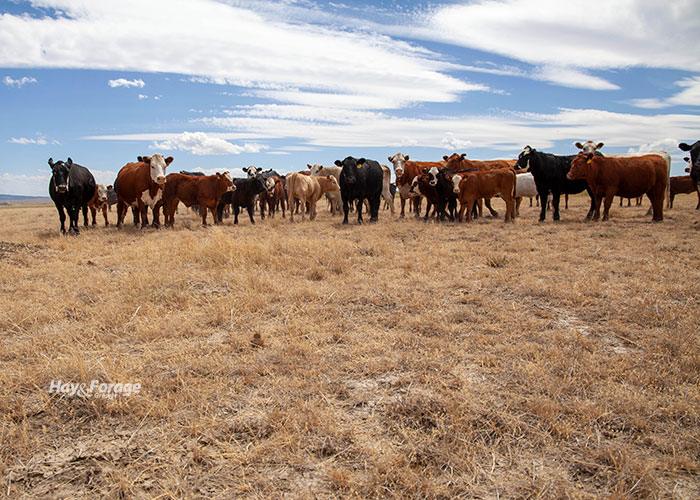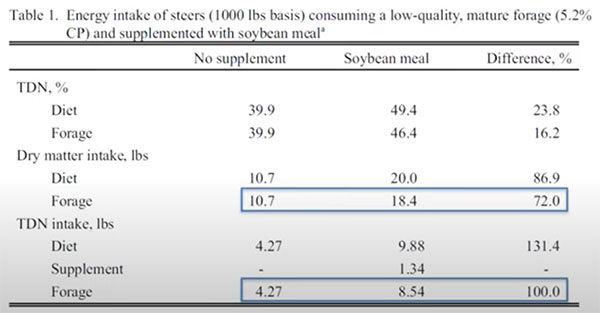
Drought is never a certainty, but having a plan to deal with it should be. Without a plan, your options to react if a drought occurs become limited.
Although the strategies for dealing with a drought are wide ranging, one approach is simply to stretch available pasture and rangeland forage resources.
“To make sound feeding decisions, producers need to know the quality and quantity of their pastures and hay inventories,” said Travis Mulliniks during a University of Nebraska Extension webinar series focused on drought planning. “During a drought, we may need to provide supplemental feed to ensure the cow herd consumes adequate energy, protein, and minerals. Another approach might be to actually reduce the nutrient requirement of the cows through a strategy such as early weaning,” added the range cow production systems specialist.
“The ultimate measure of forage quality is animal performance,” Mulliniks said. “Forage availability and intake most often determine how animals will perform. In drought years, both forage production and quality will often be lower than normal.”
As forage quality declines, so does intake potential. Mulliniks explained that for a cow milking 20 pounds per day with a calf at her side, its ability to consume enough forage to meet protein needs is compromised once crude protein concentration drops below 7% to 8%. It’s at this point when feeding a protein supplement will provide a benefit.
Protein isn’t a forage extender
The beef nutritionist cautioned growers that feeding a high-protein supplement such as distillers grains will not stretch forage supplies. In fact, the added protein will result in greater forage intake along with improved forage utilization. The result will be cows that either maintain or gain body weight. This response is demonstrated in the research summary below where protein supplementation boosted dry matter intake by 72%.

“The situation where protein supplementation will be beneficial is when a producer has large amounts of low-quality forage available to feed,” Mulliniks explained. “It shouldn’t be used if the goal is to stretch existing forage supplies.”
Proven strategies
If forage is in short supply, Mulliniks highly recommended feeding an ionophore along with a supplement, which has been found to reduce forage intake by 6% to 20%, provide cost savings, and possibly result in body weight gain through improved nutrient utilization. Ionophores have also been effective in shortening the time between calving and the onset of cycling for the next breeding season.
The beef specialist also noted that another strategy for lowering forage intake is to feed wet distillers grains with low-quality hay. This assumes the operation is close enough to an ethanol plant to source the supplement.
An approach that frequently is considered during a drought is to ammoniate a low-quality forage. “You only want to do this with straw, stover, or hay that is below about 7% protein,” Mulliniks explained. “However, it is very effective for improving the protein concentration of hay, although you still might need to add an energy supplement.”
For producers thinking about feeding corn as a supplement, Mulliniks emphasized that the cow’s protein requirements must first be met. “Feeding corn at more than about 0.2% of body weight with a low-quality forage is going to result in lower forage digestibility and reduced energy consumption,” he said.
Limit-feeding alfalfa hay is another strategy to stretch forage resources. “I use this method with a lot of producers,” Mulliniks said. “It’s both a protein source and provides degradable fiber. We have producers who feed alfalfa at about 2% of the cow’s body weight every other day, and this reduces pasture forage intake.”
Mulliniks emphasized that producers need to reduce hay waste, which is especially important when forage is short during a drought. He recommended to segregate the feeding area and only allow access to hay for 6 to 12 hours per day. This both reduces waste and prevents over consumption.
Lower nutrient requirements
“Drought conditions are one of the only times when early weaning is cost effective for most producers,” Mulliniks said. “Weaning calves at 90 to 120 days of age will reduce the cow’s nutrient requirements by about 35%. The tradeoff is that you need to be set up to manage young calves with high nutrient requirements. The calves will require a high-protein, high-energy concentrate feed and free choice access to good quality hay,” he added.
Early weaning accounts for about 10 pounds of forage per cow being conserved each day, according to Mulliniks. For young cows that are thin, research has shown a dramatic improvement in time to first heat and subsequent conception rate when calves were weaned at 6 to 8 weeks.
“Early planning for drought will offer you more flexibility,” Mulliniks concluded. “A good drought contingency plan encompasses grazing management, determining feed inventory, knowing your trigger points for specific actions, and having a herd reduction plan if conditions warrant.”

